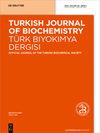Antioxidant and antimicrobial activity of East Black Sea Region honeys)
IF 0.7
4区 生物学
Q4 BIOCHEMISTRY & MOLECULAR BIOLOGY
Turkish Journal of Biochemistry-turk Biyokimya Dergisi
Pub Date : 2014-01-01
DOI:10.5505/TJB.2014.77487
引用次数: 18
Abstract
Objective: Honey possesses antioxidant and antimicrobial activities. Many chronic diseases are associated with increased oxidative stress caused by an imbalance between free-radical production and the antioxidant level. For that purpose, the total phenolic contents, antioxidant potentials and antimicrobial activities of nine honey samples obtained from East Black Sea Region was investigated. Methods: The average phenolic contents for honey samples obtained from East Black Sea Region was determined according to Folin-Ciocalteu method. For evaluation of the antioxidant activity three different methods were used, the ferric reducing antioxidant power (FRAP) assay, the 1,1-diphenyl-2-picrylhydrazyl (DPPH) radical scavenging activity assay and cupric reducing antioxidant capacity (CUPRAC) assay. The antimicrobial activity was studied by the disc diffusion method, using ten bacteria and three yeasts. Results: The average phenolic content for these samples was determined as 0.224 mg gallic acid equivalents per g honey. According to FRAP assay, antioxidative activity of honeys was between 0.973 and 9.053 μmol FeSO4.7H2O/g. But the average CUPRAC activity was found as 7.815 mol Trolox/g honey. IC50 values were found as between 29.388 and 458.450 mg/mL at the end of DPPH radical scavenging activity assay. The samples showed moderate antimicrobial activity against many microorganisms. Conclusion: All the analyzed East Black Sea Region honey samples demonstrated antioxidant and antimicrobial activity level can be considered effective.东黑海地区蜂蜜的抗氧化和抗菌活性
目的:蜂蜜具有抗氧化和抗菌活性。许多慢性疾病都与自由基产生和抗氧化水平失衡引起的氧化应激增加有关。为此,研究了东黑海地区9种蜂蜜的总酚含量、抗氧化活性和抗菌活性。方法:采用Folin-Ciocalteu法测定东黑海地区蜂蜜中酚类物质的平均含量。为了评价其抗氧化能力,采用了三种不同的方法,即铁还原抗氧化能力(FRAP)法、1,1-二苯基-2-苦味酰肼(DPPH)自由基清除能力法和铜还原抗氧化能力(CUPRAC)法。以10种细菌和3种酵母为实验对象,采用圆盘扩散法对其抑菌活性进行了研究。结果:这些样品的平均酚含量测定为每克蜂蜜0.224毫克没食子酸当量。FRAP测定表明,蜂蜜的抗氧化活性在0.973 ~ 9.053 μmol FeSO4.7H2O/g之间。但平均CUPRAC活性为7.815 mol Trolox/g蜂蜜。DPPH自由基清除活性测定的IC50值为29.388 ~ 458.450 mg/mL。样品对多种微生物具有中等抑菌活性。结论:所分析的东黑海地区蜂蜜样品具有良好的抗氧化和抗菌活性。
本文章由计算机程序翻译,如有差异,请以英文原文为准。
求助全文
约1分钟内获得全文
求助全文
来源期刊
CiteScore
1.20
自引率
0.00%
发文量
0
审稿时长
6-12 weeks
期刊介绍:
Turkish Journal of Biochemistry (TJB), official journal of Turkish Biochemical Society, is issued electronically every 2 months. The main aim of the journal is to support the research and publishing culture by ensuring that every published manuscript has an added value and thus providing international acceptance of the “readability” of the manuscripts published in the journal.

 求助内容:
求助内容: 应助结果提醒方式:
应助结果提醒方式:


